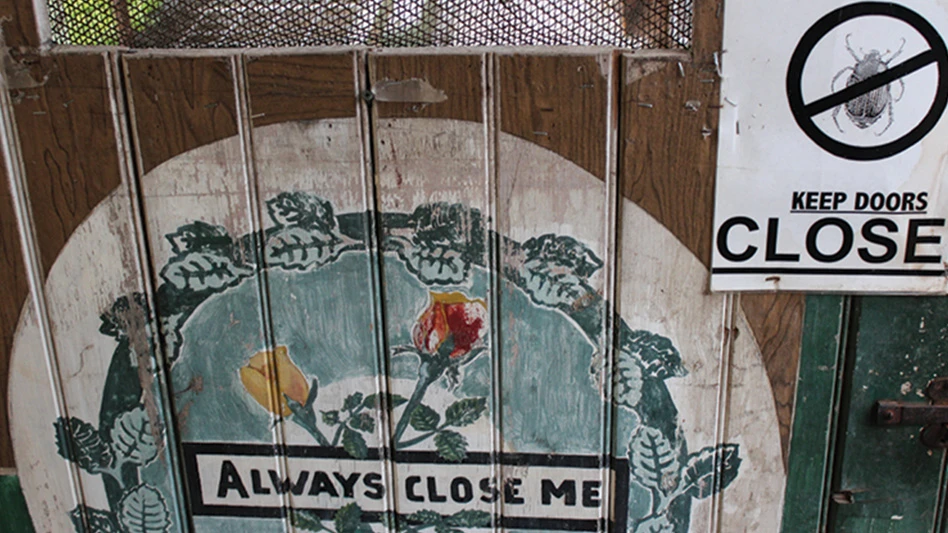

Cucurbit crops grown in greenhouse production systems, including cucumber (Cucumis sativus), are susceptible to a variety of insect and mite pests such as thrips, aphids and spider mites. For the sake of brevity, the following article will focus on the twospotted spider mite Tetranychus urticae. The twospotted spider is a major pest of greenhouse-grown cucumbers due to:
- multiple generations occurring during the growing season
- short generation time (life cycle)
- high female reproductive capacity
- a developed resistance to miticides
The twospotted spider mite has a life cycle consisting of four life stages: egg, larva, nymph and adult. The life cycle can be completed in five to seven days when temperatures exceed 80°F (26°C). Hot, dry conditions favor twospotted spider mite population growth. Adult females are approximately 1/60 inches in length. Eggs laid on leaf undersides are small, shiny, spherical and straw-colored. Eggs hatch into yellow-green, six-legged larvae that quickly mature into eight-legged nymphs and then adults.
Twospotted spider mites are primarily located and feed on leaf undersides because they are susceptible to ultra-violet light (sunlight) desiccation. A single leaf may harbor hundreds of individual spider mites. The twospotted spider mite feeds on the chlorophyll content of plant cells, causing damage often referred to as “stippling” or “speckling.” Infested leaves turn yellow with distinct interveinal yellowing or chlorosis on the upper leaf surface. Leaf undersides are tan to yellow with a crusty texture. High populations result in mites climbing up plants and producing strands of webbing, which allows mites to move between plants. The presence of mites can be determined by:
- visually inspecting leaf undersides using a 10 or 16X hand-lens
- shaking leaves over a clipboard with a white sheet of paper (8 x 11 inches) and looking for twospotted spider mites, which will appear as moving specks

Miticides may be applied to suppress mite populations; however, thorough coverage of all plant parts is important, especially leaf undersides. Furthermore, twospotted spider mites develop resistance to miticides in a short time periods due to the frequency of miticide applications and multiple generations being present simultaneously. Therefore, to mitigate the prospect of miticide resistance developing, always rotate miticides with different modes of action within a generation. In some instances, spot spraying localized infestations of twospotted spider mites may be effective in reducing the potential for resistance developing and may also help avoid the spatial distribution or spread of mites throughout the cucumber crop. The use of pyrethroid insecticides should be avoided, as many pyrethroid insecticides may increase female reproductive rate and dispersal of twospotted spider mites.
Natural enemies or biological control agents, such as the predatory mite Phytoseiulus persimilis can be purchased from most biological control suppliers and released onto a cucumber crop to regulate twospotted spider mite populations. Predatory mites must be released early in the crop production cycle to maintain twospotted spider mite populations below damaging levels. However, the hairs, or trichomes, on cucumber leaves may inhibit the searching efficiency or ability of the predatory mite to locate and consume twospotted spider mites, which may result in reduced regulation and consequently more damage associated with feeding by twospotted spider mites.


Explore the December 2016 Issue
Check out more from this issue and find your next story to read.
Latest from Produce Grower
- AmericanHort accepting applications for HortScholars program at Cultivate'25
- BioWorks hires Curt Granger as business development manager for specialty agriculture
- Bug budget boom
- Don’t overlook the label
- Hurricane Helene: Florida agricultural production losses top $40M, UF economists estimate
- Little Leaf Farms introduces Sweet & Crispy Blend
- IFPA’s Foundation for Fresh Produce to launch Sustainable Packaging Innovation Lab with USDA grant
- No shelter!





